Scouting Long Island’s Decommissioned Nuclear Power Plant
You are on page 2 of this post. Click here to go to page 1.
We stepped through the passage and into the primary containment area. The reactor is on the left…
…encased in a second containment wall about 2-3 feet thick:
Fuel rods would have been loaded into the reactor via these tracks, first passing through the seven-foot thick outer shield…
…and then into the reactor here:
Just as I was wondering how much all of this equipment weighed, I happened to notice this device…
…clocking in at a gargantuan 46,000 pounds!
An emergency stretcher in case of injury:
We then headed up about ten flights of stairs to the top level of the reactor, an enormous circular room with a gigantic 360 turning crane overhead:
The reactor pit is in the center of the room…
A look inside:
Here’s an official GE diagram of the Mark II reactor:
Nearby is the fuel rod storage pool…
…which has been cleaned and ground down to remove any irradiated surfaces:
On the other side, an enormous shaft dropping all the way to ground level offers a sense of the height of the reactor building:
We then headed over to the sprawling turbine building, where electricity was generated (reactor creates steam, steam turns the turbine, turbine generates electricity):
Here’s a higher view – the turbine spanned the center of the room:
The turbine housing is now empty and capped off:
Two of the turbines were sold, but there’s still a third left for anyone in the market! Note: it probably doesn’t work.
A peek inside the turbine shaft:
On one side is a cute box-shaped structure known as the exciter room, which sounds like a fun place to hang out (it was responsible for producing the magnetic field necessary for generating electricity):
Not much inside today:
Throughout the room are walls of modular blocks, used for protecting workers from radiation while working in a particular area:
These were moved by two enormous hooks running along the roof:
The far side of the turbine room has made an appearance in one movie so far…
…the missile launch scene in The Dictator (the control room was also used).
A chunk of dismantled turbine rests atop the structure:
From the turbine room, you can walk out onto the lower roof of the plant…
…which has a gorgeous view of Long Island Sound…
…and nearby Wading River:
Next up was Rad Containment, the third building on site.
This locker would have stored radiation casks…
A look inside:
There were a few odds and ends lying around this building, like a floor filled with more shielding walls…
This gives you a sense of their size and construction:
In another room, part of the device used to close the water pumps:
Every once in a while, you’d pass by a “Hear-Here” booth, which I imagine offered some quiet when talking on the phone in a noisy environment:
And finally, one more control room, this one dedicated to the operation of the containment building:
Just another thousand or so buttons and knobs…
…covering all three walls:
I gravitate toward the more colorful panels:
Our last stop was to the plant’s former office area:
The conference room, with views of the Sound:
As we headed out of the facility past the atrium entrance, I noticed one last amusing bit…
…a garden of fake greenery over the door, as full of life as it was the day the plant opened:
As you’ve seen above, the plant has a TON of possibilities for the right production, and while it’s a little further out, I can’t think of anything that offers such a unique collection of options. A huge thanks to the folks at PSEG for arranging the tour.
If nothing else, the plant is just begging for a horror movie to make use of its shadowy passages.
It’s pretty hard to walk through its darkened industrial spaces and not picture the alien from Alien waiting to pounce on you from above:
One neat fact to leave you with: throughout the plant, you’ll see these crosses marked all over the walls and floors, creating 3 ft x 3ft grids:
This is how the plant was checked for contamination – literally one grid at a time, throughout the entire facility.
Hope you’ve enjoyed the tour! As always, if you made it all 90+ pictures down to this final sentence and enjoyed what you read, donations to my film fund are always appreciated!
-SCOUT
Note: Before anyone asks, the plant is under security surveillance, and at least two trespassers have been sent to jail for breaking and entering in the past.



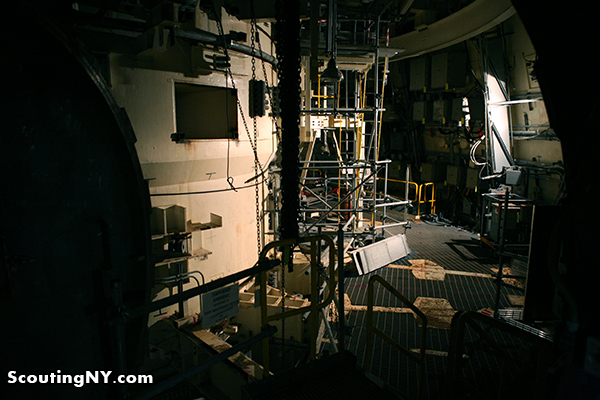
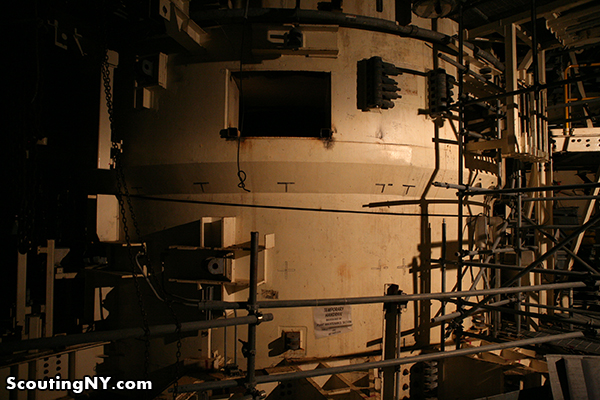


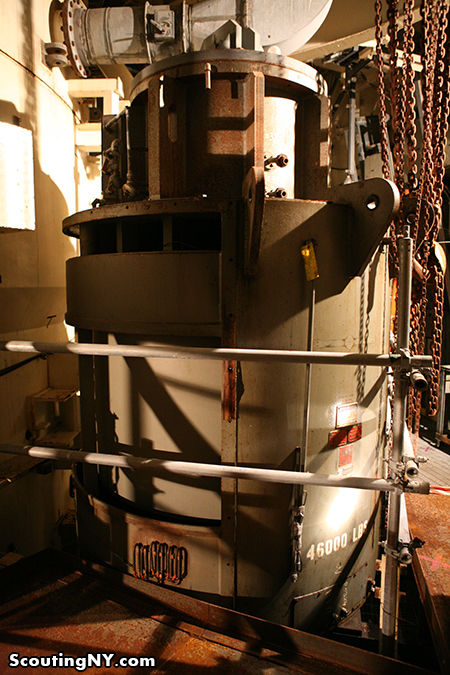
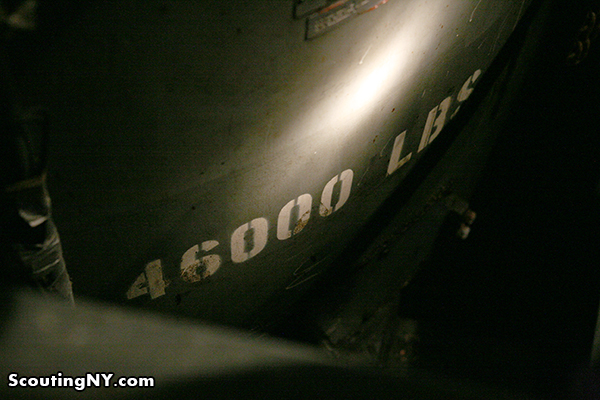


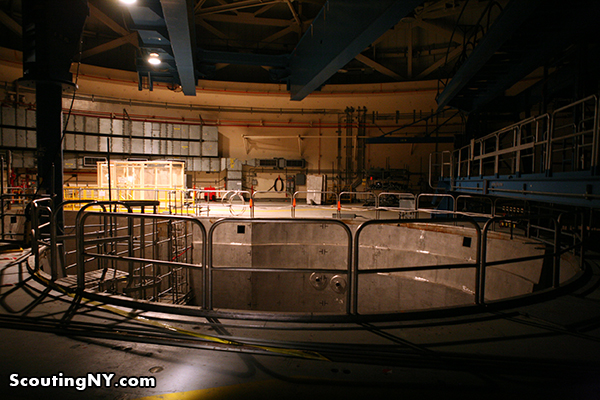
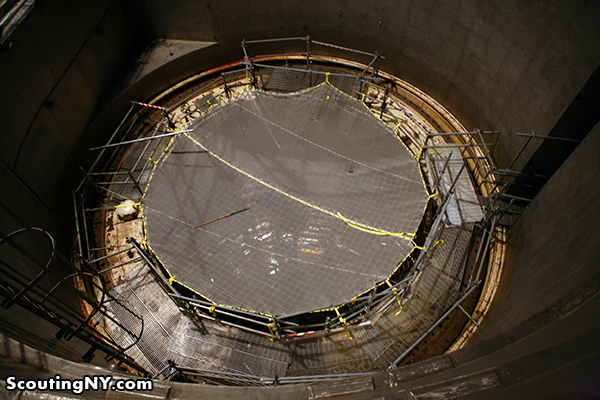

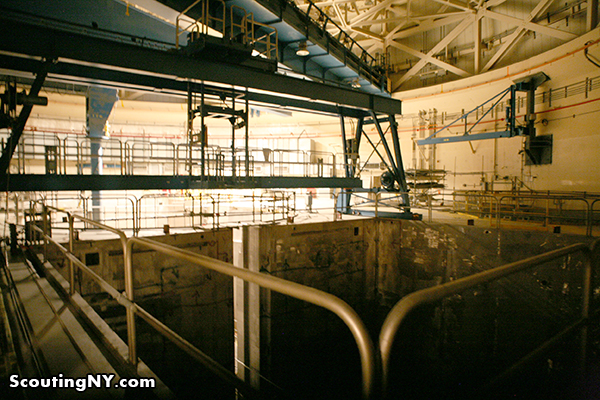
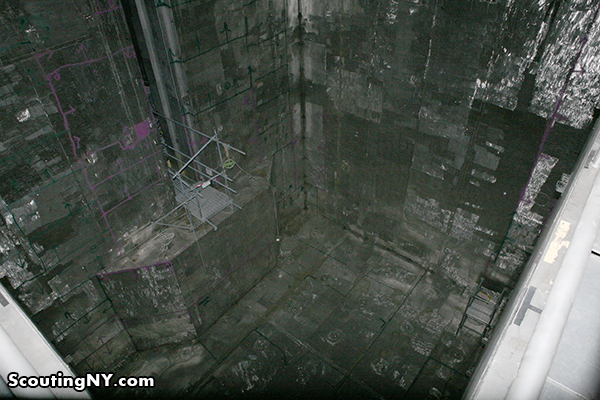
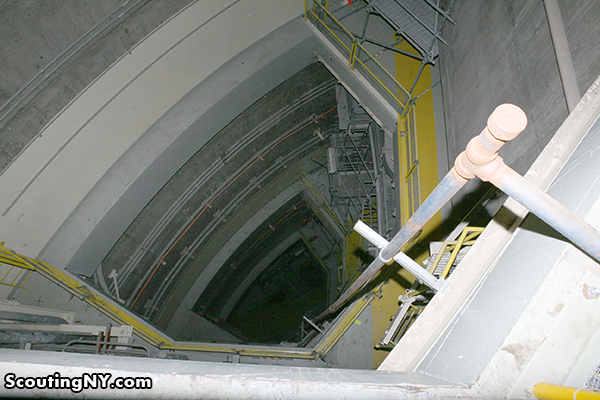
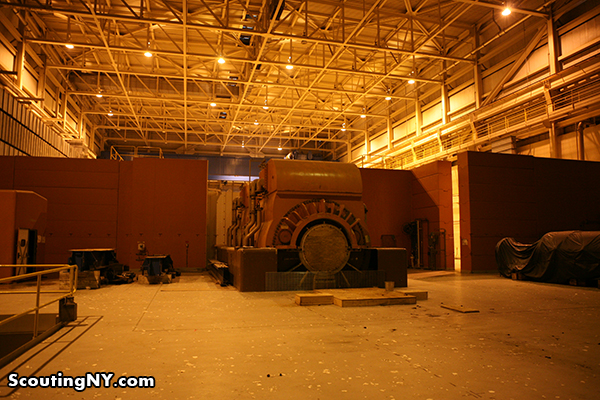

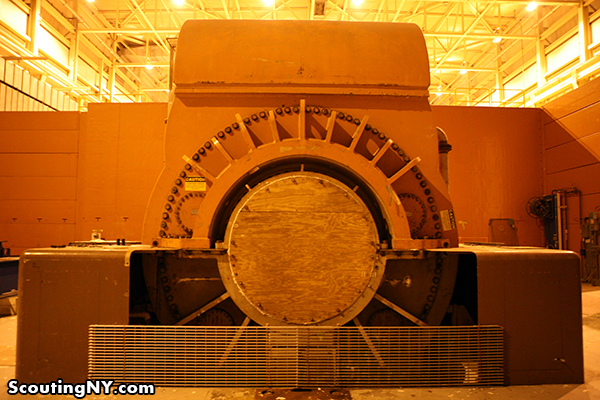
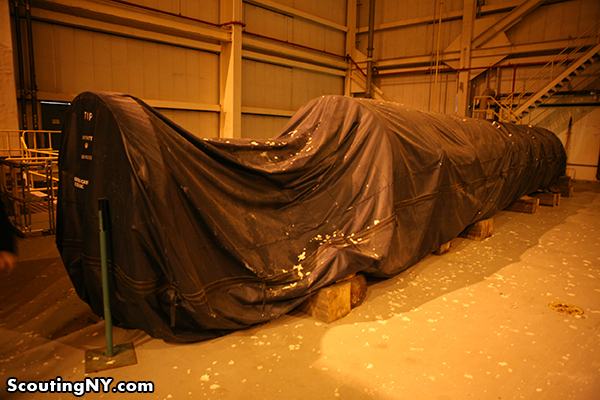

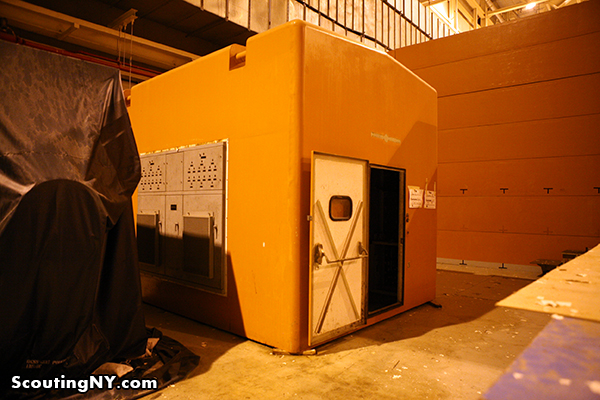
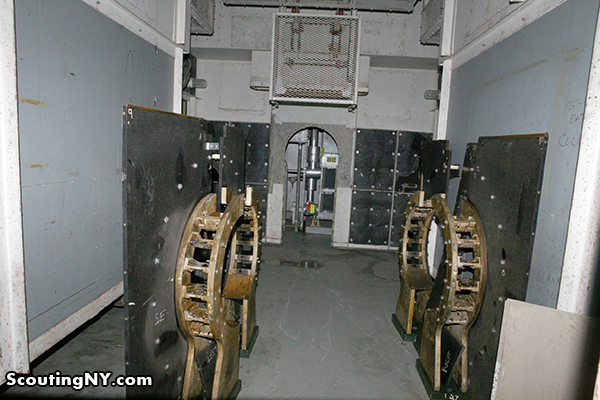
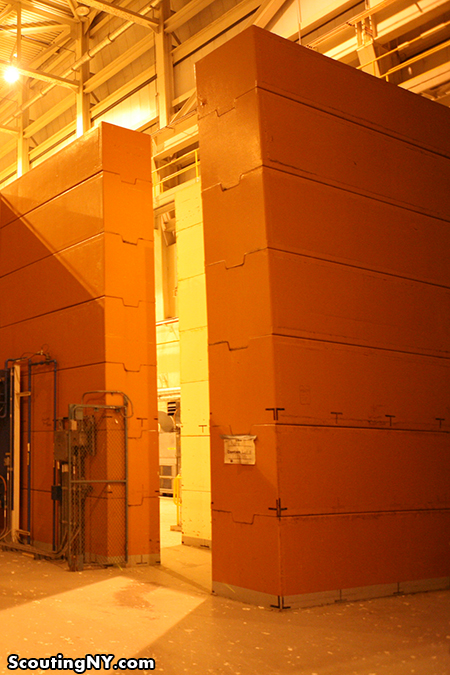

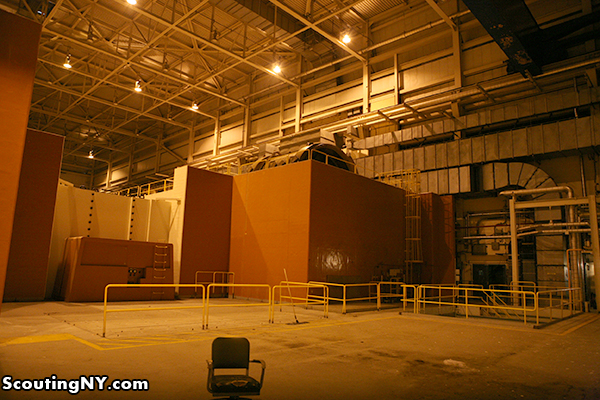
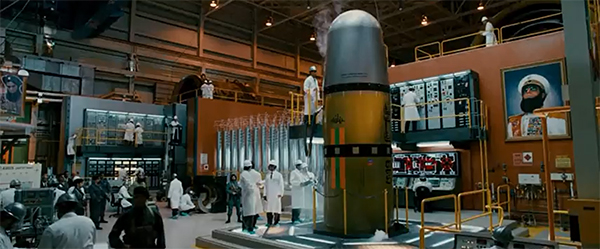
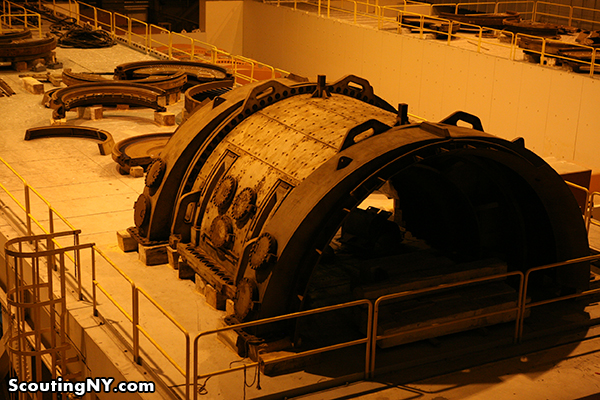
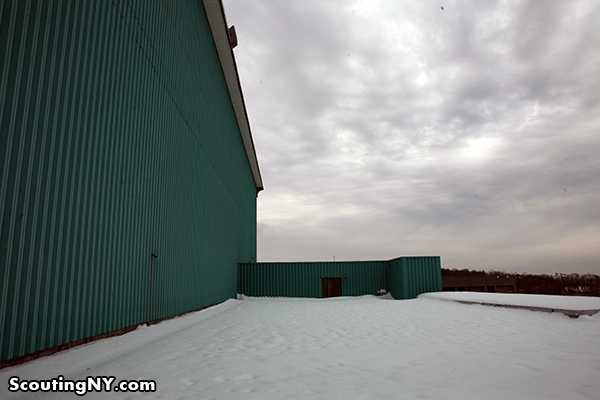
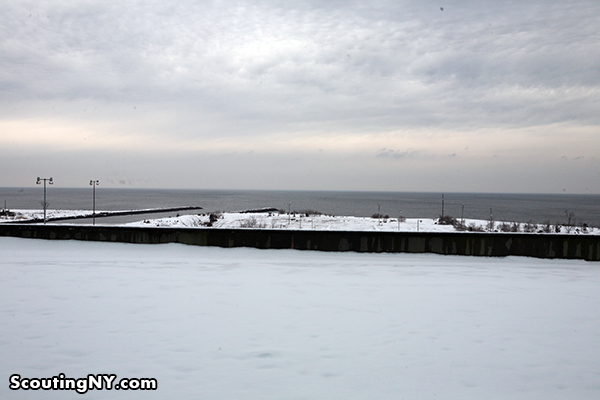
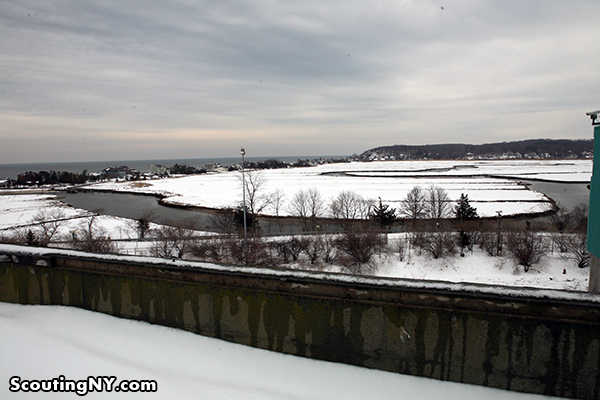
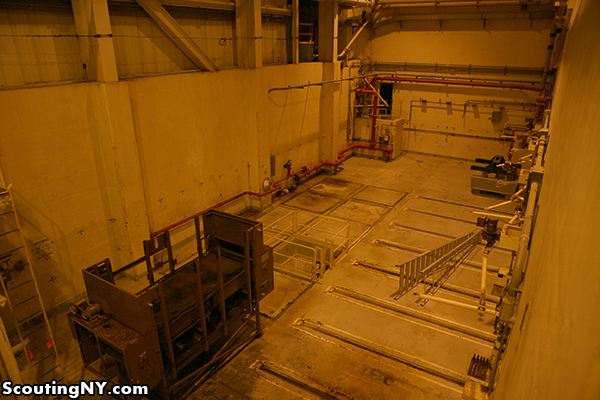
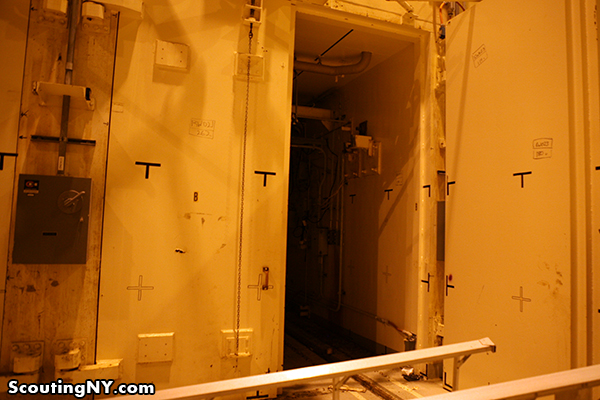

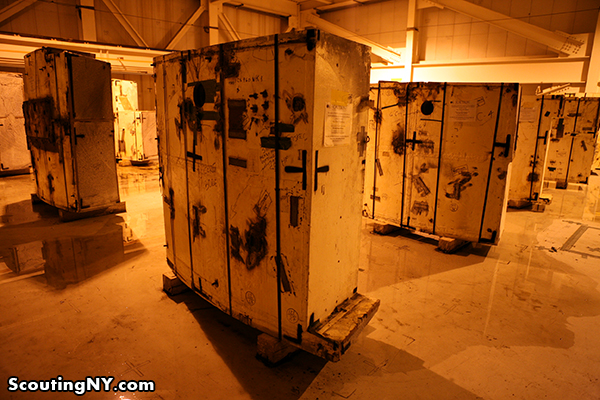

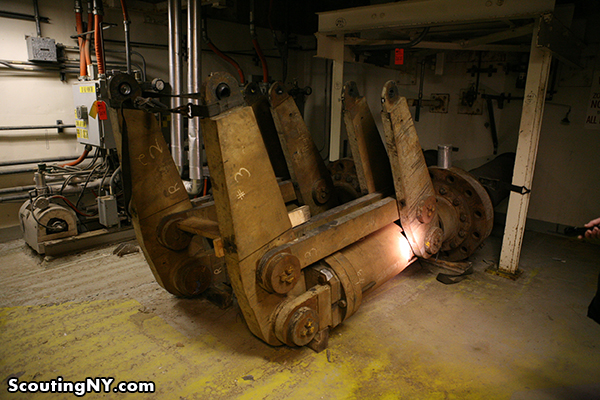
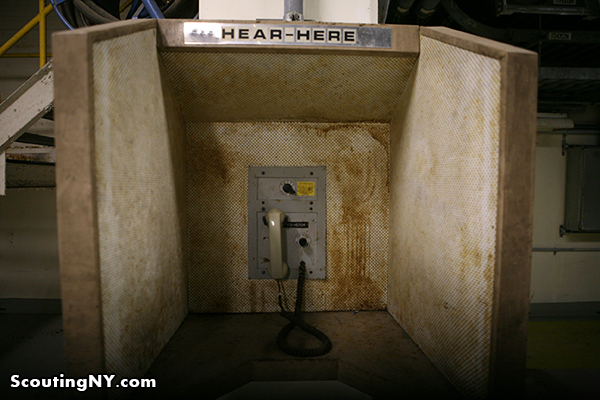
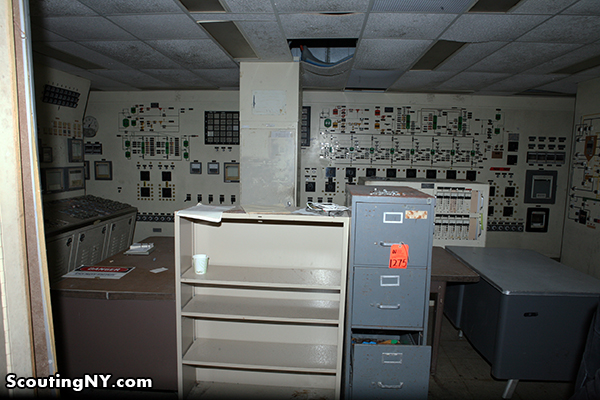


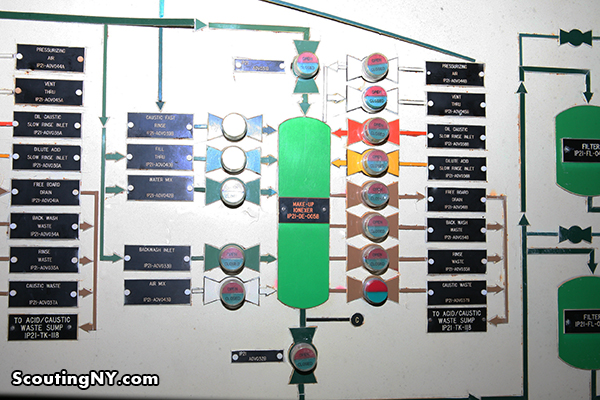
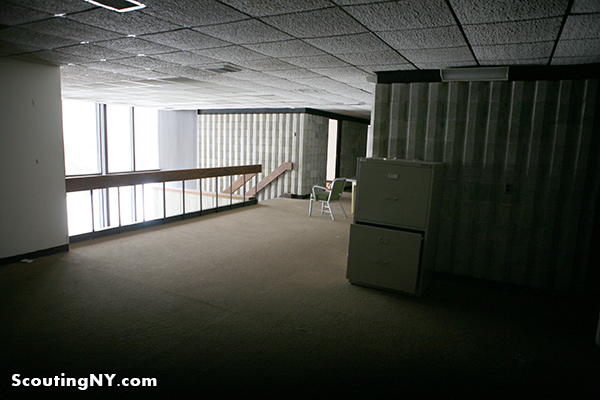
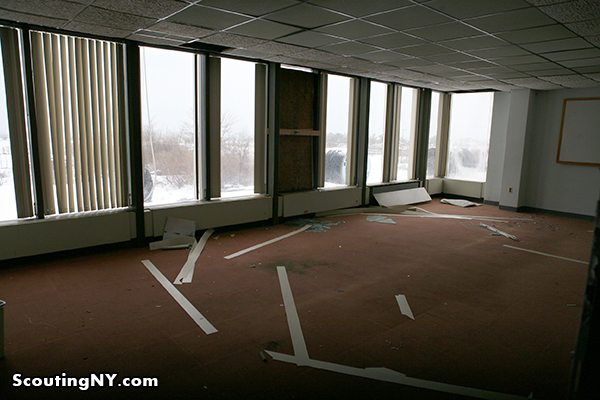
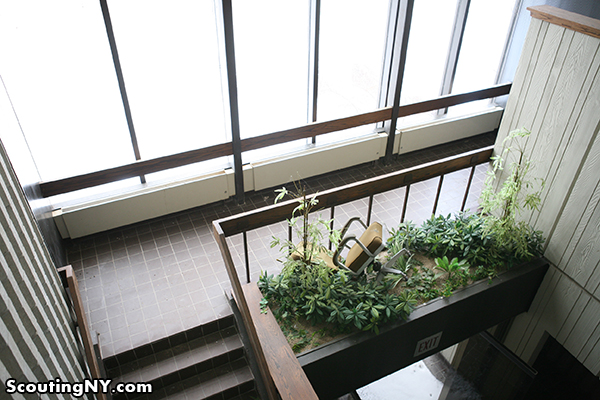

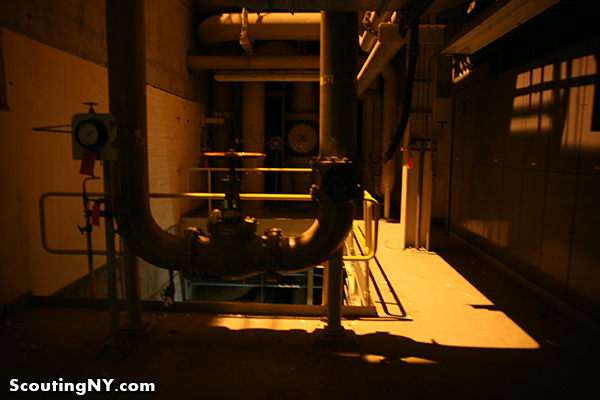
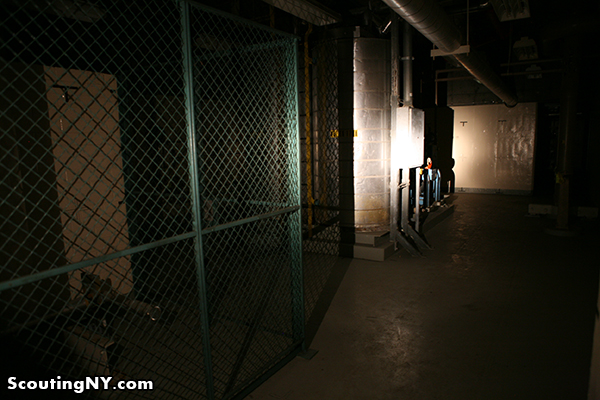
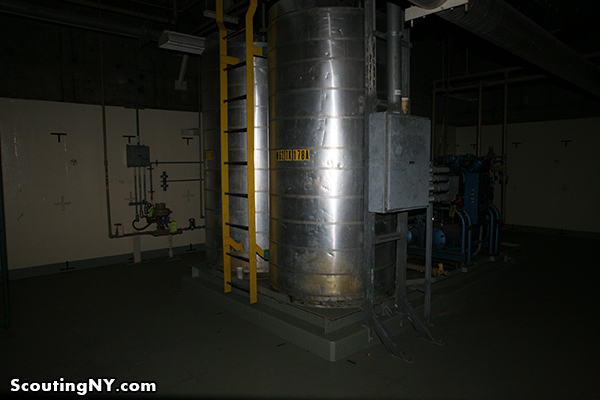



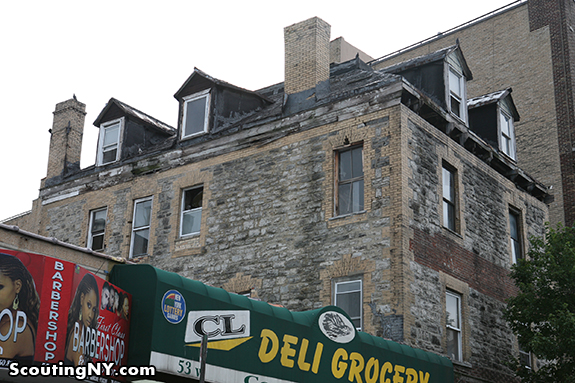
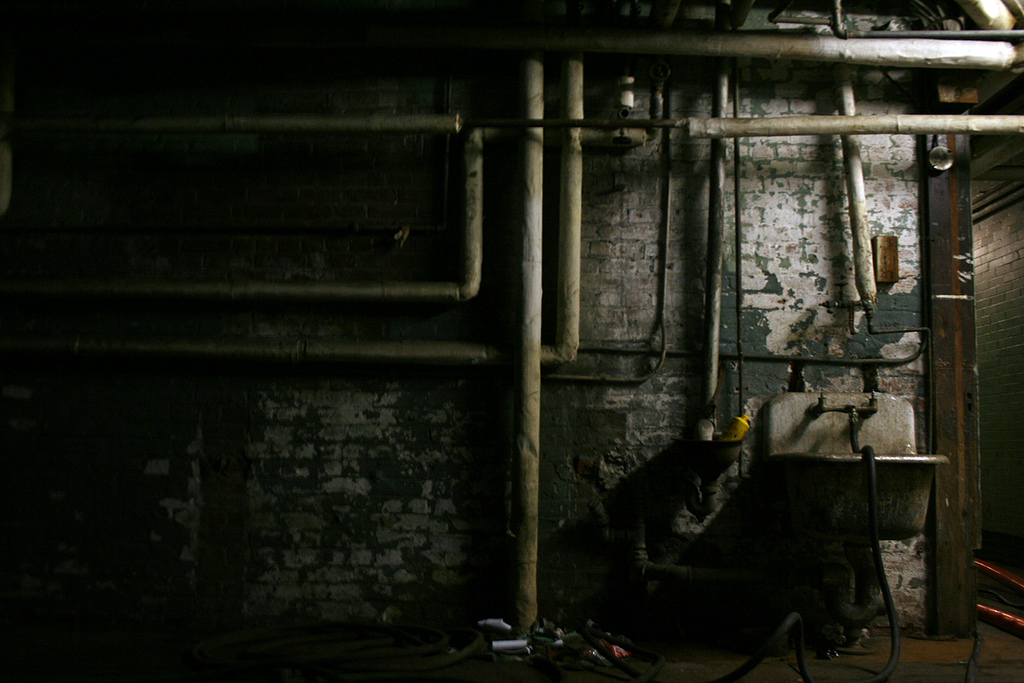

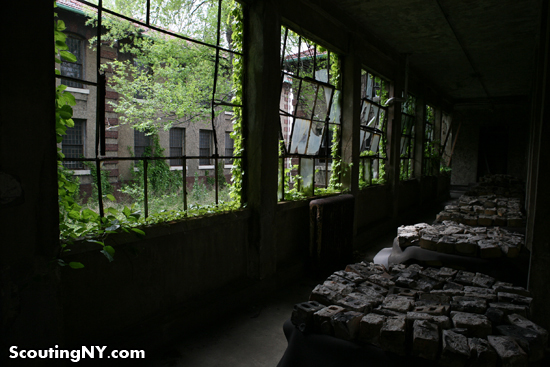
Great write-up. Hope to see it in a movie some time!
Live-action Simpsons movie?
Was thinking that too, kept see Homer in opening of the simpsons and the green radioactive rod
MomVee, I was thinking that too! I mentally inserted Homer Simpson into a lot of these pictures.
SO SO FASCINATING!!!!! Thank you for sharing this!
Let’s reunite Jane Fonda and Michael Douglas for “The China Syndrome 2: Revenge of the Isotopes.”
I can’t stop thinking about Homer Simpson meanwhile I read your great post. Thanks for sharing!
This is so friggin’ awesome! Another one that is a classic!
Great tour, looks a LOT like where I work 😉
>Every once in a while, we’d come to a large open shaft going up to the roof, giving a sense of the height.
These are the hoistways used for lowering equipment and materials to the various elevations of the building. There would have been an overhead bridge crane at one time for servicing this hoistway.
>Despite being decommissioned, equipment is everywhere, some of it still in use.
These load centers presumably still power the lighting and environmental equipment OR service the natural gas powered combustion turbine plant on the site using the existing transmission infrastructure.
>I was also intrigued by this grid of buttons, which depicts the status of the fuel rod assembly.
This is actually a display of the position of the *control rods*, not the fuel assemblies; you’ll find both in the reactor pressure vessel of course. Control rods would be raised into the core from below the reactor vessel to change the power level or immediately shut down the reactor.
>the word SCRAM
The industry urban legend (no idea whether it is true of course) goes back to the earliest research reactors where the control rods would be held up by a rope and pulley and if anything started to perform unexpectedly, the “axe man” (literally a man with an axe next to the rope) would be told to cut the rope – i.e. Start Cutting Rope Axe Man!
>Lining the top of the equipment stations were several tables of error messages, which I imagine you prayed would never light up:
A lot of these were pretty routine, a simple as it was getting close to time to change an air or water filter as the differential pressure across it started increasing. Some you very much did NOT want to illuminate!
>To enter the primary containment area, one would have to climb into this claustrophobic tube and securely close the enormous steel door…
This is called the personnel air lock. It would take a minute or so to close the outer door and open the inner door. There is usually a phone and intercom inside the air lock. Under a panel in the floor is a tool kit to allow you to remove the bolted on blind flange of an emergency air port to let in breathing air in case you got stuck.
>A phone for communicating with the outside world while sealed inside:
This is actually a GAI-tronics system handset. It lets you make a page announcement to the entire plant or communicate with another party on a specific line selected by rotating the knob below the red and white strip of tape. You can’t dial a phone number from it. The panel to the left controls the opening and closing of the doors and valves in the air lock.
> Every once in a while, you’d pass by a “Hear-Here” booth, which I imagine offered some quiet when talking on the phone in a noisy environment:
Meh, they’re not really that helpful other than identifying where a phone or GAI-tronics handset is located!
> And finally, one more control room, this one dedicated to the operation of the containment building:
> I gravitate toward the more colorful panels:
I think this control room was likely for radwaste processing or plant water chemistry. The panels discuss various waste tanks, deionizers, and acid / caustic supplies (used for bringing water to a neutral pH for further processing, use in the plant, or discharge).
Keep up the great work!
No natural gas fired plants in that area at all. In fact, No natural gas within almost a mile of that place. Those electric “peaking” plants are diesel fired units.
Indeed: http://www.jpowerusa.com/projectsShoreham.html
Most folks east of the plant were firmly against its opening, since we were essentially written off in an evacuation plan. Unless you had a boat with which to go a direction other than west, you would have been screwed.
Every horror and sci-fi movie made in the next 25 years will use this location. Wow.
P.S. Very cool comment from Jason too.
I would want to press every single one of those buttons… and flip every switch. I’m normally not OCD, but when I see buttons and switches… I go nuts. If I’m walking past a fire alarm, I literally have to walk along the opposite wall because I think I’m going to one day reach out and pull that alarm.
I have issues… 🙂
Another great tour. This building would be the perfect location for a movie or crime scene tv show.
If you take the Bridgeport-Port Jefferson ferry this plant is of only four structures on Long Island visible from the Connecticut side. The others are the smokestacks of the (conventional) power plants in Port Jefferson and Northport, and Stony Brook hospital.
Would be a good The Following episode
my husband and i loved your photos of the Shoreham Nuclear power plant.
he worked on site in nuclear engineering for many years, up until it closed.
I heard that Sacha Baron Cohen was filming a movie there a few years back.
Gotta ask, since you had to drive past it on 25A to get to the power plant, is Tesla’s old buiding still there?
Some of the building are still there, but in rough shape. An nonprofit just raised a bunch of money and bought the property to turn it into a Tesla museum. They’re over at http://www.teslasciencecenter.org/ if you’re interested, they’re usually looking for volunteers to help clean up the grounds on weekends when it’s nice too.
I worked at the Shoreham Nuclear Plant for two years. I still remember the day coming up the drive and the stacks coming into view…it was like I was coming upon a movie set. Met wonderful people, some of which I still keep in touch with today…and all with a common goal to get this plant online. I worked on many of the “drills” and you would absolutely swear the melt down, or whatever other scenario they came up with, was actually happening. There was deadpan seriousness in that room and everyone had a job to do and took it VERY seriously. It always impressed me to see the dedication of those people who worked on that plant and worked so tirelessly to get it ready to open. Probably the most safest nuclear plant ever built…such a shame it never came on line. We could use that power today!!!
I agree such a shame it never opened. My dad worked there several years and very proud of it.
Yes, it is a shame it never came to be. People are still paying for it and they got what they wanted. Trouble is that most people want this and that, as long as it is not in there back yard. If all you can do is complain about this and that, then you to are part of the problem. “Put it in someone else’s back yard, not mine”
All the flickr links go to a page that says “Oops! You don’t have permission to view this photo”.
Great photos! (but would love to see bigger versions)
Best place I’ve ever worked at Miss SNPS…..!
I worked at SNPS for over a dozen years as a security supervisor. These pictures sure brought back a lot of lost memories. The best job I ever had in my over 50 year working career. What a waste of time and money decommissioning this plant. This plant was ready to go, as were all of us dedicated employees. SNPS …gone but never forgotten.
Hi Skip !
I stumbled across this archive of photos today and was taken way back in time!
I remember you in the Security Dept., before it was YOH Security even. I was in Operations
Dept from 84 to 94. I was friends of Jim and Steve Diagostino from your Security team.
Anyway, it is sad to think of what a monumental waste it was to throw that plant away.
The photos of what’s left deteriorating is quite amazing. Never thought that the day would
actually arrive that they would throw it all away when I first got there. Good memories working
there.
Wendle L., SNPS badge no. 849
Wendle, What shift were you on in Ops?. I worked there from 80 to 89 and was a SRO Shift Supv working with Bill Nazzaro and later Tony Matasich (not sure of the spelling.
Joe Guttieri
Hello Joe !
Thanks for coming to take a look at what’s left of the most incredible nuclear financial disaster in history! Simply amazing what they did to the place I thought we’d all retire from.
As for my shift, I was on C crew, as I remember calling it. Came in November 84 as EO. Bill Nazarro and Warren Uhl’s crew; and Dean Rhinehardt as NSO. We had Marty O’Brien out in Rad Waste Control and a thin guy, with the shakes, named Jim who smoked constantly, as the veteran EO. We had Kevin Dingle, as the 3rd EO.
After the 84-86 Hot License class finished John Santiago and Phil Plunkett came on C crew as NASO’s in the Control Rm and Wayne Loris as NSO. Dean got his SRO and was promoted to Watch Sup. I went to RO Cert in Hauppauge from 86-88. Got license and came back to C crew under Peter R. Miller, WE and Rick Reeves, WS. John S. got promoted to NSO on another crew. I stayed for most of the decon and fuel shipping till April 94 and was allowed to post for Gas Customer Service job out of Queens/Nassau. Ended up driving to Rockaway Park, 108th Street my first year from Shirley! (63 miles).
Anyway, I remember you well, Joe. You were in the operator group with Mike Gardner, Mike Dugan, Rick Andersen, etc. When I got to Shoreham, I thought you were on Willie Charvat or Pop Holly’s crew? ; not sure. Little sketchy there. But, anyway, memories of SNPS do not go completely away, they just fade with some sort of half life! How bout this—
You always impressed me as a sharp dresser in the control room, so I learned how to do the Guttieri “shirt tuck” way back then. You didn’t know I copied that from you. That is the absolutely only “tuck” for every button down shirt, to this day! Never leave home without it.
Take care. Good to see your post. I’m in Solar Power Operations now, just recently after years in Combined Cycle generation. Never went back to nuclear after I saw them bores holes in the Shoreham pressure vessel. That paradigm was destroyed for me, but life went on. Have a great day!
Wendle Lehnerd
bwinc8@gmail.com
I worked at SNPS from 82-94. The real irony is that the much revered BNL was the true nuclear nightmare. The stuff that was going on over there would have been great news fodder for Newsday but for some reason they received the “golden child” status. I worked there from 94-2000 after I got excessed from Radiochemistry. A truly fascinating place, but safety and environmental regulations did not receive exactly …what we from SNPS would call…verbatim compliance. The place was a radiological/hazardouos waste disaster area. Left BNL in 2000 and ended up in Maine’s Radiation Control Program. Nice landing spot, but I still haven’t made my 1994 SNPS salary. Control Room line 1, Control Room line 1….
Yet another detailed and well-thought out post! thank you
I find it tragic that the people of Long Island has to eat that extra 3% over the sale of the property. $1?!? What an outrage.
Real dinosaurs died and decomposed millions of years ago. This modern dinosaur will be an eyesore forever. And just think of the cost just involved in decommissioning this plant to this sorry state. Just say no to nuclear!
“Fuel rods would have been loaded into the reactor via these tracks, first passing through the seven-foot thick outer shield…” is not quite correct. That access is for removing and replacing the control rods, which on a BWR enter from the bottom. The fuel was loaded from the top when the reactor vessel head was removed during outages.
Other wise, this is a great set of pics!
Thank you Jason for explaining the to the people especially the narrator about what they really were looking at. You were spot on, since I was there as an operator for many years. Crew “C” to be exact. The pictures do bring back many memories. For that I thank the scout for braving the elements 🙂 .
Nick,
I worked on that Decommissioning from early 1992 to July 1994, on the Termination Survey (the final radiological cleanliness survey). Thanks for the trip down memory lane….even got to see my old office window from the outside.
Couple of corrections I could offer: the plant actually was granted a full power operating license by the NRC…on a Friday; the following Monday, the utility (LILCO then, LIPA now) and the State of NY announced the decision to abandon the plant…talk about a blow to the solar plexus of everyone who had sacrificed family time to meet all those milestones! Unfathomable.
The second photo of additional “shielding walls” actually shows walls that were once intact but contaminated at a low level. The walls were cut apart and left standing at these spatial intervals to fall below the allowable radiation levels set by the NRC at the time (“dilution is the solution”). In fact, I wrote the work instruction for applying those grid marks that you see on the structures, defining one square meter.
Not every grid was surveyed….the draft NUREG at the time allowed for random or systematic surveying of some areas, depending on the degree to which the area was affected by reactor operation. Certainly, in the containment, every floor grid received a measurement.
You do refer to the “reactor” in your photo captions….actually, the reactor vessel was cut up and removed in rings by a radial cutting arm….kind of like cutting a tin can into rings, working from the inside. The metal was sold to the US Govt to serve as shielding material in areas of their facilities with even higher levels of radiation.
The fuel itself was shipped by barge to the Limerick power plant in Pennsylvania, which could use it in its reactor…in fact, Limerick was paid to receive the fuel. (“May I gas up your car? In fact, let me pay you to receive the gas, and I’ll even deliver it to you”…what a deal!)
Please feel free to consult me for any other “behind the scenes” stories you might be interested in….there’s a great film waiting to be made about that Shoreham project itself.
Fabulous post! Long Island holds plenty of surprises. Back in the late 70s, we considered building a custom home near Huntington. The real estate agent showed us several properties, one of which had a decommissioned, empty missile silo.
That Control Room! What a fantastic tour, Nick! Seriously appreciate you sharing this with us!
I worked for Stone &Webster Engineering. I was the youngest Administrative Asst. At age 20. I met my husband there, who recently passed but would h ave enjoyed all of these photos. My father worked there as well, a union Sheet Metal foreman. Thank you
My good friend, Nora Bredes, was the most instrumental person in stopping this plant. She later went on to become a Suffolk County legislator and was just an all around amazing woman, friend, and mother. She passed away a few years ago from breast cancer but I know stopping Shoreham was one of her proudest achievements.
The irony…She dies of Breast Cancer ( was that Shoreham’s Fault?) I wouldn’t consider such a tremendous waste of resources and potential an achievement by any stretch .
paying a 3 percent surcharge on electric Bills for 30 years to fund something that was never realized . How is that an achievement to anyone ? Paying another utility to take fuel rods?? Oh yeah! Long Islanders made out on that deal …
LONG LIVE Nuclear Power !
Thank you for the photos
+919649673702 call me
What a waist, all of the money spent to plan and build and then to sell to the state for a dollar just to spend more of our money for decommissioning. Very, very sad state we live in, shame on New York!
I worked there for 8 1/2 years and can recognize everyone of those pictures. I worked in every part of that facility. So did many others. It had three backup systems in addition to the normal operational systems. It was safe as any one of them at the time. For those protestors out there consider this when you are sitting in your dark unheated house someday in the future. Driving a car to the local stores is much more dangerous then this plant was. The earth is not flat.
I did security for LILCO during the evacuation drills. No local officials participated in the drill (political suicide). The NRC ruled that NRC and FEMA officials could roleplay those positions with the assumption that if there were an accident they would participate. Their plan involved using buses to evacuate people, but no bus company volunteered. Sirens were to sound to warn people of the emergency, but on the day of the test only a fraction of them functioned and most residents didn’t hear them. They still passed this regulatory hurdle.
The whole exercise was rather surreal.
I got my start in the Nuclear industry at SNPS. I worked in the LILCO Project Office with some of the finest Engineers and Admin Staff. Before I left I was involved with the Transamerica Delaval Emergency Diesel Revalidation. I remember LILCO bringing in Failure Analysis Assoicates (Same Company with the TV Show “What Happened”) to provide high tech engineering and legal services. FAA has a trailer located by the EDG’s which looked like a NASA Control Room to me at the time. FAA had a transmitter the size of a small shoe box strapped to the Crank Shaft to measure dynamic flex, strain gauges attached to the cracked engine block. All in an effort to revalidate the design on these diesels. LILCO ended up bringing in 4 EMD Diesel’s from New England Electric and replaced the TDI’s with Colt Pielsticks EDG’s. What a shame that LILCO invested so much money only to see ~ $8 Billion wasted which was in-turn passed on to the customers because it became a Political football under Gov Mario Cuomo administration. His son is trying to shutdown Indian Point, only to leave Fossil Fuel generating stations to produce electricity. The ironic part of Shoreham is that not too far away were mutilple test Nuclear Reactors at Brookhaven National Labs which I’m not sure many Long Islanders were aware they existed there for years.
Oh, that computer room is nothing short of beautiful.
I loved/hated working there (82-94) Hated mostly because of the mind numbing shift rotation !! Slid over to BNL for 6 years. That place was crazier and less safe from many perspectives than Shoreham…for sure!! It was also an AMAZING facility…or more correctly a collection of amazing facilities.
Hey, any other Shorehamites out there?
Hey Steve, Joe Guttieri here. I remember your name, but can’t remember your face.
I was one of the Operations SRO Shift Supervisors and left in 89 right after they announce the shutdown. I ended up working for Westinghouse at the Savannah River Site. Talk about stepping into the dark ages of Nuclear power! I lasted there about 2 years after which I said goodbye to Nuclear Power.
Simply beautiful write up and amazing pictures. My question is how does one set up a tour of this facility. I’ve been trying to find a location for a film I’m working on as a school project and from the pictures this could have a lot of potential so how does one get a tour and permission to use this location?
As an employee at then New Hampshire Yankee (Seabrook Station) during the late 80’s and finally receiving our full power license in the early 90’s we watched this situation with great interest. Having done the low power testing then seeing the station shut seemed like a terrible waste. The photos are awesome……
WOW! I just came across the photos! Boy, does this bring back memories! I haven’t seen the inside of the plant since I left in 89 after the closing was announce. I was in Operations and was a Senior Reactor Operator & Shift Supervisor. I along with the Shift Manager were responsible for the operation of the plant. During the back shifts the entire plant staff reported to the operations staff. This included IC, Health Physics and Maintenance. My office, which overlooked the control room, is the room shown in the photos with the standing fan, two desks and a few bookcases. I was fortunate enough to start working at the plant in 1980 when it was approximately 75% complete, and had the opportunity to climb, crawl and walk through every square inch of the plant prior to pulling the first criticality. I was on shift when the one of the Trans America emergency diesel generators snapped it’s crankshaft, which ultimately delayed our start up and gave the anti-nuke people more ammunition to use in their arguments against opening the plant. I was also on shift for the initial criticality. Unfortunately the state of the art plant fell victim to cost overruns, delays, bad press, the anti-nuclear movement, Three Mile Island, and even Chernobyl. I loved working there, despite the horrid shift work, and I loved the people who I worked with They were the most professional people I ever had the opportunity and privilege to work with and for. I miss them all. Occasionally I get back to LI to visit family and my old house, and once in a while I drive by the plant for old times sake. Thanks for sharing the great photos and story. Too bad you couldn’t see the suppression pool directly below the reactor vessel. The suppression pool looks like something right out of a scii-fi movie. Hopefully I’ll see it in some movie someday.
Hi Joe, I remember working with you, Jerry Bobka, John Dugan Sonny Lum, Rick Reeves ,Tony Mattesich, Tom Davis, Greg Good Pete Davisson, Gerry Gauding and a lot of others. It was a great place to work with great people. Carlos Harris, Holly Hartwell, Neal Hughes and I took a job at a plant in the Midwest. Neal left after a few years and we heard he passed away about 5 years ago. Carlos, Holly and I are all retired now and I see them from time to time. I still talk to Tom Davis and Gerry Gauding every once in awhile.
I think the guys sweeping the floors made $17 – $20. an hour back then. I knew an electrician who worked there. He said when they finished a task then ripped it out and did it again. Ditto. This is what I was told first hand. I lived in Rocky Point (Next Door Town) at the time. We all knew it would never opened. At least a lot of good workers made lots and lots of money.
Yes, that’s what I was told. The plant was sitting offline so long that parts/design would become obsolete.
Hello, I enjoyed seeing all the photos! I am into photography and I enjoy taking photos of old architecture and various other things. My friend and I drove out there this past weekend to get some shots of the building but since I could not find an exact address online, we couldn’t find it! ha ha. We did stumble upon a road that took us to a view of the plant but from across the water. Can you tell me the exact address? Or tell me what is across the street from it? I know it is down a long road. We went down a bunch of those but could not find it. Also, how were you able to get a tour of the place? Who do I contact for that? Thanks!
Wow…looks like I replied to this already…and I keep coming back to the site. Like Wendell said Joe, it has a memory half life. I dream of the place far too often. The plant was a magnificent machine. And Stripers in the river to boot!!
I worked at Lilco Start Up from 83-85’ish as a secretary right out of HS. My brother and his ex also worked there. To this day, best job I ever had and just an awesome bunch of people. Wish I had stayed till the end. Grew up in WR, moved away and now am back in my hometown and there the plant still sits. Can’t say my grown up self would work at a nuclear plant, but my younger self had a blast. Ironically, my parents were anti-nuke and participated in the protests at the gate, but bless their heart, they never said a word to me about working there.
Sort of a bizarre question, but does anyone have any idea if you can visit the plant whether it be the interior or the exterior? Any sort of tours? I’m a high school history teacher and I’m teaching a nuclear history class this year to my 11th and 12th graders. It’d be a real treat to visit!
I’ve been fascinated with the Shoreham Nuclear Power plant ever since I saw it for the first time in 2005. I remember hearing about it when I was like 7 or 8, but didn’t really care/ didn’t think about it because, well, I was 7 or 8. I always wanted to drive up the road that brings you up to the place, but I didn’t want to get into trouble. I actually drove past it a few days ago. These pictures are really great, and seeing the interior of the place that’s basically frozen in time is fascinating
I’m somewhat ambivalent about the whole situation; on one hand, the cost of electricity might have been lower, and the odds of a catastrophic meltdown were/are pretty low, but on the other hand, *if* anything did happen, people living in the surrounding area would have been *really* screwed. It’s really unfortunate that the place became a 6 billion dollar paperweight, however.